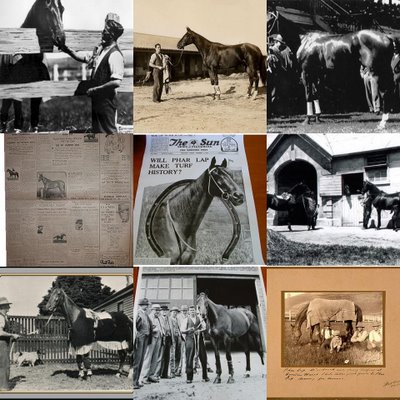Test proves Phar Lap poisoned!!!!! BASTARDS

By staff writers and wires
October 23, 2006 10:11am
THE death of Phar Lap - Australia's greatest sporting mystery - has finally been solved, but the people behind it may never be unmasked.
The Daily Telegraph revealed exclusively that secret scientific tests using breakthrough technology have uncovered evidence the legendary racehorse was poisoned with arsenic just hours before his 1932 death in the US.
The startling revelation adds credence to the theory Phar Lap was killed on the orders of US gangsters, who feared the Melbourne Cup-winning champion would inflict big losses on their illegal bookmakers.
Scientists used a US synchrotron, or particle accelerator, to unlock the 74-year-old riddle of Phar Lap's mysterious death.
The proof lies in Phar Lap's hair.
A scientific report shows a large dose of arsenic was ingested by Big Red about 35 hours before his agonising death in California on April 5, 1932.
"The arsenic in the hair structure is consistent with a single large dose of arsenic," the report says.
The exact cause of his death was never proved, with suggestions ranging from the foul play theory to acute bacterial gastroenteritis.
But evidence of an arsenic overdose has been uncovered by scientists bombarding a strand of Phar Lap's hair with a beam of intense light.
"We've made observations which could be explained by poison," Australian Synchrotron Research Program scientist Dr Ivan Kempson said "We can't explain it by any other way."
But Dr Kempson conceded that proving it was a poisoning does not help identify who was behind it.
"All the material that we have can only indicate that he has ingested arsenic, we can't actually identify where it's come from,'' Dr Kempson said.
Dr Kempson and Museum Victoria's Dermott Henry made the Phar Lap breakthrough by searching for minute traces of chemicals in the structure of Phar Lap's hair.
Hair incorporates blood products and these can provide a timeline of exposure to toxins that can be unlocked using synchrotron technology.
In 2000 the technology was used on six strands from a lock of Beethoven's hair to identify the cause of his illness and death - lead poisoning.
The latest CSI-style hunt to find what killed Phar Lap began in February last year when a sliver of hide was cut from his preserved skin.
The 2mm square sample was cut from beneath the mane. A whole hair was then removed from the sample hide and analysed at a synchrotron outside Chicago in June last year and June this year.
The tests revealed a high concentration of arsenic.
"The arsenic in the hair structure is consistent with a single large dose of arsenic between one to two days prior to death," the scientists' report says.
The arsenic stretched about 900 microns along the hair from the root bulb, with a potentially deadly concentration found between 450 microns and 500 microns.
Assuming a growth rate of 1cm a month, the scientists estimated Phar Lap was poisoned 35 hours before he died. Tests on two more hairs produced the same results.
The behaviour of arsenic in the hair strand was also consistent with results from a test on the hair of a pig that had been poisoned with arsenic.
There were, however, some anomalies. Strong traces of arsenic found on the root bulb of Phar Lap's hair and hide produced a different chemical signature and were also associated with traces of lead.
Dr Kempson said this suggested it was a different arsenic that may have come from lead arsenate used to preserve Phar Lap's hide.
They hope to find another horse hide preserved around the same time to test this theory.
Arsenic was also detected on two hairs taken from Phar Lap by his owner before his death.
But only the post-mortem samples had traces of arsenic inside the hair structure that were consistent with the behaviour of ingested arsenic in the hair of the poisoned pig.
"You will never get a 100 per cent definite answer that you're confident there is no doubt about it," Dr Kempson said. "But we can't explain it by any other way than the scenario of poisoning."
On the morning of Phar Lap's death, trainer Harry Telford found him in severe pain and with a high temperature. A few hours later Phar Lap collapsed and died, blood spurting from his lungs as he haemorrhaged to death.
A necropsy showed his stomach and intestines were inflamed.
There have been many theories on what caused the giant five-year-old's agonising death, including accidental poisoning from lead insecticide.
But many, including Tommy Woodcock - Phar Lap's devoted strapper - remained adamant the champ had been murdered by US racing and crime interests who feared an unbeatable outsider.
But with no evidence, poisoning could not be proved.
A stomach condition caused by rotten or bad feed was widely accepted as the most probable cause.
In 2000, equine specialists reviewed two necropsies and concluded Phar Lap had probably died of Duedentis-Proximal jejunitis, an acute bacterial gastroenteritis formally identified in the 1980s.
- Peter Mickelburough, The Daily Telegraph and AAP
LinkHere
Phar Lap arsenic claim rejected
SOME racing experts are unconvinced by claims that new evidence solves the mystery of the death in 1932 of the legendary racehorse Phar Lap.






0 Comments:
Post a Comment
<< Home